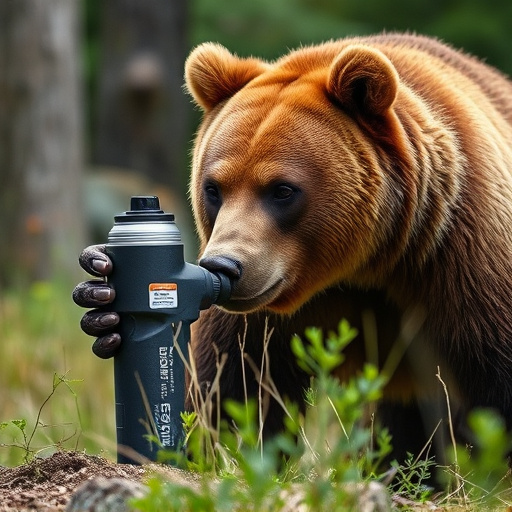Bear spray, effective against bears down to -40°F, needs proper storage above 75°F to prevent freezing and maintain potency. Keep it in cool, dry places away from direct sunlight and extreme temps, out of reach of children and pets, following manufacturer's recommendations for duration and expiration. Prolonged sub-zero exposure can damage the spray's projection and intensity, so indoor storage or insulation is advised.
“Wildlife encounters, especially with bears, can be frightening and dangerous. One widely recommended safety measure is bear spray, but its effectiveness hinges on understanding how it interacts with various factors. This article delves into the dynamics of bear spray, exploring key elements like freezing dynamics under different conditions, optimal storage practices to prevent malfunction, and the spray’s performance against environmental variables. Moreover, we scrutinize a prevalent concern: can bear spray freeze in storage? By addressing these aspects, readers will gain crucial insights for safe wildlife encounter protection.”
- Understanding Bear Spray Dynamics
- Factors Influencing Bear Spray Freezing
- Safe Storage Practices for Bear Spray
- Effectiveness vs. Environmental Conditions
Understanding Bear Spray Dynamics
Bear spray, also known as bear repellent, is a crucial tool for anyone venturing into bear country. Understanding its dynamics is key to effective use and storage. One common concern is whether bear spray can freeze in cold environments during storage. It’s important to note that quality bear spray is designed to withstand low temperatures, typically down to -40°F (-40°C), ensuring its effectiveness remains intact throughout the year.
In terms of usage, bear spray creates a barrier of irritants that temporarily incapacitates bears, allowing individuals to escape or defend themselves. The active ingredients, usually capsaicin derived from chili peppers, cause pain and discomfort in the eyes, nose, and respiratory system. Proper application involves aiming for the face and chest area of the approaching bear, creating a cloud of spray to disrupt its behavior without necessarily causing harm.
Factors Influencing Bear Spray Freezing
Bear spray, an essential tool for wildlife encounter protection, can be a game-changer in potentially dangerous situations. However, one concern often raised is whether this spray can freeze during storage, especially in colder climates. The freezing point of bear spray is a critical factor to consider, as it directly impacts its effectiveness and usability. Several elements influence the potential freezing of bear spray, including temperature, humidity, and storage conditions.
In regions with harsh winters, low temperatures can indeed cause bear spray to freeze. However, modern bear spray formulations are designed to resist freezing at typical storage temperatures, ensuring their viability year-round. Proper storage in well-insulated containers or storage units that maintain consistent temperatures above the freezing point can prevent freezing and ensure the spray remains ready for use when needed.
Safe Storage Practices for Bear Spray
Proper storage is crucial to ensure the effectiveness and safety of bear spray. When not in use, store it in a cool, dry place away from direct sunlight and extreme temperatures. It’s important to note that bear spray can be sensitive to freezing conditions, so always keep it inside your home or in a vehicle with controlled temperature rather than leaving it outdoors. A suitable storage location should maintain consistent temperatures below 75°F (24°C) to prevent the spray from freezing or becoming compromised.
Additionally, store bear spray out of reach of children and pets, just like any other household hazardous material. Keep it in its original packaging with the label intact for easy identification. Always follow manufacturer recommendations for storage duration and expiration dates, as these factors can impact the spray’s performance and potency over time.
Effectiveness vs. Environmental Conditions
Bear spray is a popular tool for outdoor enthusiasts and wildlife managers alike, offering a non-lethal means of deterring aggressive bears. However, its effectiveness can be influenced by environmental conditions, particularly temperature. One common concern is whether bear spray can freeze in storage or during use in cold climates.
In ideal conditions, bear spray is designed to remain effective down to very low temperatures. The active ingredients, typically capsaicin-based, are resilient and won’t be compromised by frost or ice. Yet, prolonged exposure to sub-zero temperatures might affect the spray’s projection and intensity. If frozen, the can could become damaged, causing leakage or even rupture, and compromising the spray’s accuracy. Therefore, proper storage in cold environments requires insulation or indoor facilities to prevent freezing and maintain optimal performance when needed.
Bear spray, while an effective deterrent against bears, faces challenges related to freezing during storage, especially in colder climates. Understanding how environmental conditions and proper storage practices can impact its effectiveness is crucial for ensuring safety when venturing into bear country. By adhering to safe storage guidelines, such as keeping it in a warm location and maintaining the canister’s integrity, users can maximize the reliability of their bear spray. Regularly checking expiration dates and staying informed about product dynamics are additional steps to ensure its viability when needed most.
